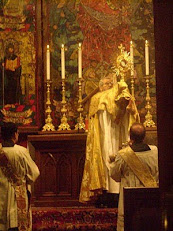Monsignor Andrew Burnham, Assistant to the Ordinary, writes in the latest edition of The Portal:
The Ordinariate is sometimes attacked for being rather small, and therefore fairly insignificant in the ecclesiastical landscape. We are sometimes laughed at. We sometimes make others angry or bitter. Given that Anglicans are famous for being attached to particular churches, and part of particular communities, it sometimes amazes me that anyone at all joined the Ordinariate. Yet 1,000 people did so, barely twelve months ago, and others are presently undertaking the Lenten journey, with their eye on being received and chrismated this Easter. Meanwhile, we have 60 clergy, and there are some more on the way.
For fun, I thought I would have a look on the internet and see what a small church in this country should look like. Slightly larger than the Ordinariate – with 120 clergy, some sixty centres, and a considerable band of faithful – is the archdiocese (as we would call it) of the Greek Orthodox Church. The Russian Orthodox are in two groups. The diocese of Sourozh, linked with the Moscow Patriarchate, has a couple of dozen active clergy, serving the liturgy in a couple of dozen centres, and the Russian Orthodox Church Outside Russia (ROCOR) in this country is about half that size. So the Russian jurisdictions, combined, are smaller than the Ordinariate, though they have some property and a good number of lay people. I looked then at a Catholic diocese, and I looked at the one associated with our patron, Our Lady of Walsingham. In the diocese of East Anglia, there seem to be some 90 clergy and just over 100 places of worship: in terms of priests and centres, a bit bigger than the Ordinariate. In terms of laity, no doubt much bigger – but much more long-established.
In short, as a brand new particular Church, we are doing very well indeed. We are part of the universal communion tracing its history back to Caesarea Philippi, when Christ called Peter the rock and said, ‘on this rock I will build my Church’, (Mt 16:18). And we are learning what it feels like to be a Catholic. I now fully understand and increasingly share the feeling that mediæval churches and cathedrals are really ‘ours’, stolen by Tudor apostasy. I cannot see why their ownership and use, if it cannot be restored, cannot at least be shared. This is a view I have held since, as a cathedral chorister, I watched, fascinated, as a modern Catholic Church was built in Southwell. ‘Why duplicate?’, I thought.
The General Synod has made it entirely plain that, whatever space is given to Anglo-catholics, the historic justification for being an Anglo-catholic – bringing the whole Church of England to understand and embrace an inherent Catholic Faith and Order – has now gone for ever. Meanwhile we long for our Anglican brothers and sisters to come and join us in the full communion of the Catholic Church, not because of this or that issue, but because Rome is home. RITA – Rome Is The Answer – as people used to laugh at me for saying. And perhaps still do.
From the Portal Magazine, March 2012














No comments:
Post a Comment